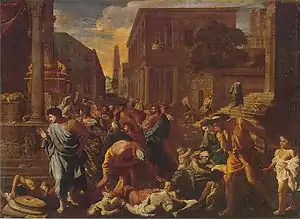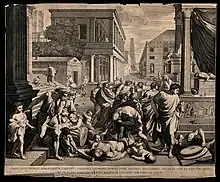Plague of Ashdod (Poussin)
The Plague of Ashdod is also known as The Miracle of the Ark in the Temple of Dagon, by the French artist Nicolas Poussin. The painting represents a story from 1 Samuel in the Old Testament. The original painting currently hangs in the Louvre in Paris. Poussin was commissioned to paint The Plague of Ashdod by Fabrizio Valguarnera. Fabrizio Valguarnera was a Sicilian merchant who was put on trial for laundering money through the purchase of this painting; he also commissioned more than one version of this piece.[1] Poussin painted this during a plague that took place in Italy from 1629 to 1631, which influenced his accurate portrayal of the epidemic.[2]
| The Plague of Ashdod | |
|---|---|
 The plague of Ashdod, 1630 | |
| Artist | Nicolas Poussin |
| Year | 1628–1630 |
| Medium | oil on canvas |
| Dimensions | 148 cm × 198 cm (58 in × 78 in) |
| Location | Louvre, Paris |
Background
Artist
Nicolas Poussin was a French artist who was born in 1594 in Les Andelys, Normandy. Poussin's life ended in Rome in 1665. During the time that Poussin began working on this commission of the Plague of Ashdod, there was a terrible bubonic plague outbreak in Italy from 1629 to 1631. Poussin was then living in Rome, which the plague actually did not infect at this time; however, Poussin was still influenced by this epidemic when creating the Plague at Ashdod. Many who have studied this painting by Poussin have been fascinated with his advanced knowledge of the nature of the epidemic.[2] Poussin wrote his Observations on Painting after 1627. His writings and observations included his understanding of the epidemic. It had valuable information that gave insight to the plague; however, the text was never completed.[2] In these writings, Poussin discusses Aristotle’s concept of loyalty.[2] To describe people who lack loyalty, Aristotle used the example of family members who murder each other due to contagion. Poussin describes how Aristotle wrote about family members murdering each other because of the fear of disease. Poussin symbolized this lack of loyalty by portraying a man ripping a child away from the corpse of the baby's mother. This might possibly lead to this man's own demise just like that of a child so attached to his or her own mother would become infected with the plague and die as well. This lack of loyalty is shown all throughout this painting.[2]
Subject
The subject of this painting comes from a story in the Book of Samuel in the Old Testament of the Bible about the Plague of Ashdod. According to 1 Samuel 5:6,7 in the NIV: "Now the hand of the LORD was heavy on the people of Ashdod and its vicinity, ravaging them and afflicting them with tumors. And when the men of Ashdod saw what was happening, they said, “The ark of the God of Israel must not stay here with us, because His hand is heavy upon us and upon our god Dagon.” Poussin himself called this art piece; "II miraculo dell'Arca nel tempio di Agon," meaning The Miracle of the Ark in the Temple of Dagon. This name refers to the temple of Dagon, which was destroyed in battle. Sheila Barker has written that this same battle in which the Ark of the Covenant was taken in this Biblical narrative.[3][2] The theft of this Ark was believed to have unleashed God's wrath and started the plague.[4][3]
Interpretation
One interpretation of the story of Plague of Ashdod stems from a story of the stolen Ark of the Covenant by Philistines during battle.[3] Because this Ark had been stolen, it was believed that plagues sent by the Judaeo-Christian God ravaged the city, riddling the people with disease and death.[3] The purpose of these plagues would be a punishment and cause for the Ark of the Covenant to be returned to the Hebrews from whom it was stolen. Poussin depicts rats throughout the painting running around the bodies of the living and the dead. According to Asensi; when the Philistines sent the Ark of the Covenant back to the Hebrew people, it was sent with a "guilt offering" consisting of five gold rats and five gold tumors.[3]
Seventeenth-century depictions of plague
Paintings depicting the plague are rare because, during the seventeenth century, a common belief was that viewing something such as a plague in art would have detrimental physical repercussions. It was believed that one would manifest what they were viewing and would literally come down with an epidemic such as the plague itself.[4] So strong were these widely accepted beliefs, that this caused images of disease to be very unpopular. Poussin's depictions of the people gesturing to cover their noses show his belief at the time that the breath of plague victims could have been contagious, or possibly the fact that the stench coming from the dying and diseased people was so bad that others had to cover their noses in order to avoid the stench.[2]
Accuracy
Plague figures that seem to be portrayed accurately are the hungry baby being pulled away from his dead mother's breasts, so that the baby would not become infected with the plague from the blood and milk of the mother. These images are particularly disturbing because people at this time would have been comforted by seeing the Madonna feeding her suckling baby, a symbol of life and safety for Catholics and Christians. To see this baby torn away from the infected mother seems almost inhumane.[2] Pestilence could then be seen as unprotected by the Madonna and as life threatening.[2] The man saving the child is risking his own life by doing so, which shows the courageousness of this figure. Poussin may have put this figure there to amplify the deep anger the viewer was meant to feel when viewing parts of the Plague of Ashdod.[2] One problematic figure in this painting is at the bottom of the statue of Dagon; there is a large relief that has yet to be interpreted.[2] There is also a woman carrying a toddler to the right of the Ark being watched by another man that has been unidentified as well as. The identification of the group of men that accompany the staring man is also unknown. According to Boeckl, these figures do not directly relate to the Biblical passage about the Plague of Ashdod, so these figures must be portrayals of Poussin's own interpretation of the epidemic.[2]
Other versions
London version
%252C_i_filistei_attaccati_dalla_peste_ad_azot%252C_01.jpg.webp)
In 1630, during the same time that Poussin was commissioned to paint this piece, by Fabrizio Valguarnera, Fabrizio was having an exact replica made before the first was even completed. This commission was given to Angelo Caroselli. Valguarnera's reasons for ordering this commission have been questioned. Ann Sutherland Harris writes that the London version of The Plague of Ashdod was used by Fabrizio Valguarnera to launder stolen jewel money through.[5][1] According to Sheila Baker, Fabriozo Valguarnera was indeed seeking to launder his money through paintings when he visited Poussin's workshop in 1631.[2] This was when he first purchased two paintings by Poussin, one of which was The Plague of Ashdod.
Engraved version
The engraved version was done by Etienne Picart in 1677. It hangs in the print room gallery at the National Galleries in Scotland.

Notes
- Harris, Ann Sutherland (2008). Seventeenth-Century Art and Architecture. London: Laurence King. p. 291.
- Barker, Sheila (April 2019). "Poussin, Plague, and Early Modern Medicine". The Art Bulletin. 86 (4): 659–689. doi:10.2307/4134458. JSTOR 4134458.
- Asensi, Victor; Fierer, Joshua (April 2019). "Of Rats and Men: Poussin's Plague at Ashdod". Emerging Infectious Diseases. 24 (1): 186–187. doi:10.3201/eid2401.AC2401. ISSN 1080-6040. PMC 5749463.
- Boeckl, Christine M. (1991). "A New Reading of Nicolas Poussin's "The Miracle of the Ark in the Temple of Dagon"". Artibus et Historiae. 12 (24): 119–145. doi:10.2307/1483417. JSTOR 1483417.
- "The Plague at Ashdod [Nicolas Poussin]". Sartle – Rogue Art History. 24 June 2015. Retrieved 12 May 2019.
References
- Asensi, V; Fierer, J (January 2018). "Of Rats and Men: Poussin's Plague at Ashdod". Emerg Infect Dis. 24 (1): 186–187. doi:10.3201/eid2401.AC2401. PMC 5749463.
- Barker, S (2004). "Poussin, Plague, and Early Modern Medicine". The Art Bulletin. 86 (4): 7–9, 659–89. doi:10.2307/4134458. JSTOR 4134458.
- Barker, Sheila (2004). "Poussin, Plague, and Early Modern Medicine". The Art Bulletin. 86 (4): 659–689. doi:10.2307/4134458. JSTOR 4134458.
- Blunt, Anthony, "The Paintings of Nicolas Poussin" "A Critical Catalogue,"no. 1&2 (London: Phaidon) (1966):1628–1630.
- Boeckl, Christine M (1991). "A New Reading of Nicolas Poussin's "The Miracle of the Ark in the Temple of Dagon"". Artibus et Historiae. 12 (24): 119–45. doi:10.2307/1483417. JSTOR 1483417.
- Butler, T (2014). "Plague history: Yersin's discovery of the causative bacterium in 1894 enabled, in the subsequent century, scientific progress in understanding the disease and the development of treatments and vaccines". Clin Microbiol Infect. 20 (3): 202–9. doi:10.1111/1469-0691.12540.
- H. H. Mollaret, J. Brossollet, "NicolasPoussin et 'Les Philistins frappes de la peste,'" Gazette des Beaux Arts LXXIII (1969), pp. 171–75, 176–77.
- Picart, Etienne. “The Plague of Ashdod.” National Galleries of Scotland, National Galleries of Scotland, www.nationalgalleries.org/art-and-artists/156082/plague-ashdod.
- “The Plague at Ashdod [Nicolas Poussin].” Sartle, 3 July 2018, www.sartle.com/artwork/the-plague-at-ashdod-nicolas-poussin.
- Viole O'Neill, Ynez (2003). "Images of Plague and Pestilence: Iconography and Iconology". Bulletin of the History of Medicine. 77 (4): 945–47. doi:10.1353/bhm.2003.0185.
- 1 Samuel 5:6,7, Holy Bible, New International Version,Copyright © 1973, 1978, 1984, 2011 by Biblica, Inc.